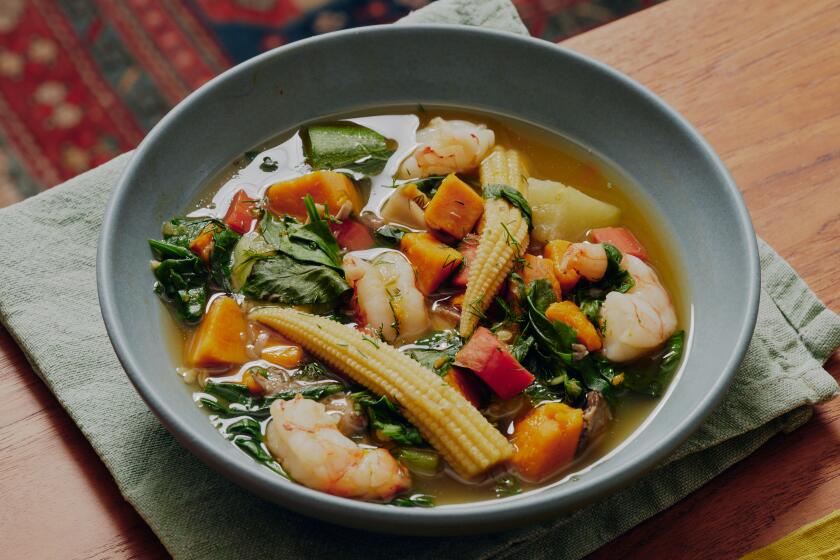Garlic Shrimp With Asparagus
Although sauteing is at the top of my list, any cooking technique produces good shrimp--grilling, frying, braising in sauce, boiling in a flavorful liquid or steaming. Shrimp are more affordable and easier to prepare than most shellfish, are less temperamental than fish, and they don’t fall apart when you stir them.
I rarely buy these crustaceans ready-cooked. Their flavor and texture can’t compare to the sweetness and succulence of home-cooked shrimp. The few minutes they take to cook is time well spent.
At the store, shrimp may be labeled with a number such as 3 1/35, which indicates that 31 to 35 shrimp make one pound and is more precise than “medium” or “large.” A higher number means smaller shrimp and usually a lower price. I find 30 per pound convenient for most purposes. Some markets, menus and recipes call large shrimp prawns.
Peel shrimp before sauteing for easier eating. Remove the thin legs and, beginning at the wide (head) end, gently peel the shell from the belly toward the back. Pull off the shell segment at the tail’s end if you like.
For attractive jumbo shrimp, remove the black threadlike vein, actually part of the digestive tract, from its back. (In smaller shrimp it’s often not noticeable and you can skip this step.) To devein a shrimp, make a shallow incision along the length of its back and, if you see a dark thread, pull it out with the tip of a knife or with your fingers. If cooking the shrimp unpeeled, slit the shell down the back with a sturdy knife and devein.
Once the shrimp are cooked, use their juices to saute mushrooms, asparagus or green beans. The colorful shrimp and vegetable medley is perfect over angel-hair pasta, linguine, couscous or rice. Another time turn the sauteed shrimp into a terrific topping for baby greens or a sensational seafood pizza. Or simply serve fresh, crusty bread such as a baguette or ciabatta for sopping up every drop of the savory sauce.
*
Faye Levy is the author of the three-volume “Fresh From France” cookbook series (Dutton, 1987-90).
Combine the shrimp shells, wine and 1 thyme sprig or 1/2 teaspoon dried in a saucepan. Cover with water and bring to a boil. Simmer uncovered for 15 minutes. Strain the stock and measure 1/4 cup.
Cook the asparagus uncovered in a saucepan of boiling salted water until not quite crisp-tender, about 2 or 3 minutes. Drain the pieces, reserving the liquid, rinse them with cold water and drain well. Measure 1/4 cup cooking liquid.
Heat 1 or 2 tablespoons of olive oil and 1 tablespoon of butter in a large heavy skillet over medium-high heat until sizzling. Add the shrimp, salt and pepper and cook, tossing often, for 1 1/2 minutes. Add the garlic and cook, stirring, until the shrimp turn pink and are just cooked through, about 1 minute; when you cut one at its thickest part, it should be white inside. Spoon the shrimp into a bowl.
Wipe the skillet clean, then heat 1 tablespoon of oil and 1 tablespoon of butter in the skillet over medium-low heat. Add the asparagus, salt and pepper to taste and cook, stirring, for 1 minute. With a slotted spoon, transfer the asparagus to the bowl.
Pour the measured shrimp stock and asparagus liquid into the skillet. Boil, stirring often, until the liquid is reduced to about 1/3 cup, 1 minute. Add the tomatoes, remaining tablespoon of butter, parsley, remaining thyme and cayenne to taste, if using. Return the shrimp and asparagus to the pan and toss over medium-low heat until heated through. Taste and adjust seasoning. Serve hot, with lemon wedges.
Get our Cooking newsletter.
Your roundup of inspiring recipes and kitchen tricks.
You may occasionally receive promotional content from the Los Angeles Times.















